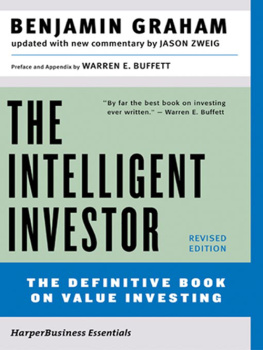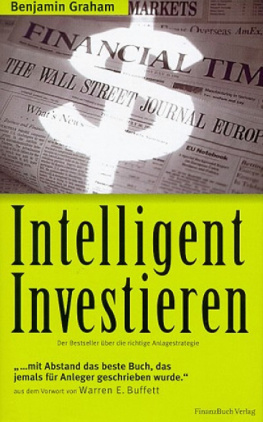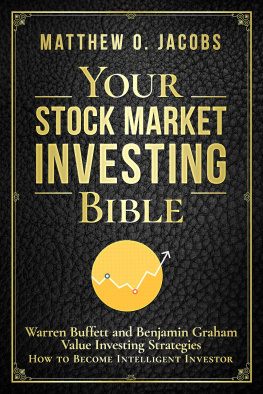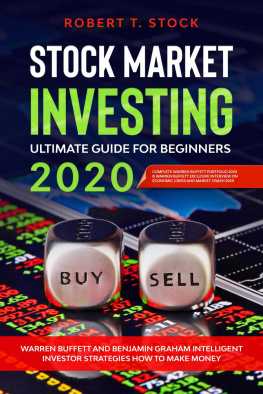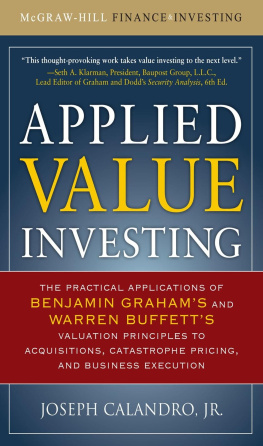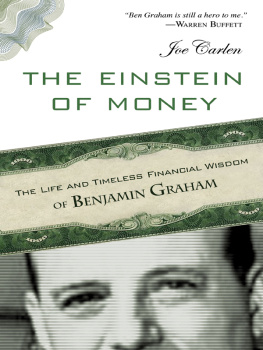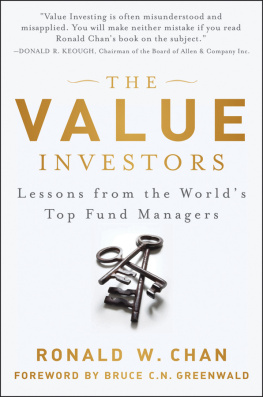This chapter is from Security Analysis, which has withstood the test of time as well or better than any investment book ever published. Now the Sixth Edition updates the masters ideas and adapts them for the 21st centurys markets. This second edition, which was published in 1940 and still considered the definitive edition, has been updated by a dream team of some of todays leading value investors. Featuring a foreword by Warren E. Buffett (in which he reveals that he has read the 1940 masterwork at least four times), this new edition of Security Analysis will reacquaint you with the foundations of value investingmore relevant than ever in the tumultuous 21st century markets.

Copyright 2009 by The McGraw-Hill Companies, Inc. All rights reserved. Except as permitted under the United States Copyright Act of 1976, no part of this publication may be reproduced or distributed in any form or by any means, or stored in a database or retrieval system, without the prior written permission of the publisher.
ISBN 978-0-07-171608-6
MHID 0-07-171608-4
The material in this eBook also appears in the print version of this title: ISBN: 978-0-07-159253-6, MHID: 0-07-159253-9.
All trademarks are trademarks of their respective owners. Rather than put a trademark symbol after every occurrence of a trademarked name, we use names in an editorial fashion only, and to the benefit of the trademark owner, with no intention of infringement of the trademark. Where such designations appear in this book, they have been printed with initial caps.
McGraw-Hill eBooks are available at special quantity discounts to use as premiums and sales promotions, or for use in corporate training programs. To contact a representative please email us at bulksales@mcgraw-hill.com.
TERMS OF USE
This is a copyrighted work and The McGraw-Hill Companies, Inc. (McGraw-Hill) and its licensors reserve all rights in and to the work. Use of this work is subject to these terms. Except as permitted under the Copyright Act of 1976 and the right to store and retrieve one copy of the work, you may not decompile, disassemble, reverse engineer, reproduce, modify, create derivative works based upon, transmit, distribute, disseminate, sell, publish or sublicense the work or any part of it without McGraw-Hills prior consent. You may use the work for your own noncommercial and personal use; any other use of the work is strictly prohibited. Your right to use the work may be terminated if you fail to comply with these terms.
THE WORK IS PROVIDED AS IS. McGRAW-HILL AND ITS LICENSORS MAKE NO GUARANTEES OR WARRANTIES AS TO THE ACCURACY, ADEQUACY OR COMPLETENESS OF OR RESULTS TO BE OBTAINED FROM USING THE WORK, INCLUDING ANY INFORMATION THAT CAN BE ACCESSED THROUGH THE WORK VIA HYPERLINK OR OTHERWISE, AND EXPRESSLY DISCLAIM ANY WARRANTY, EXPRESS OR IMPLIED, INCLUDING BUT NOT LIMITED TO IMPLIED WARRANTIES OF MERCHANTABILITY OR FITNESS FOR A PARTICULAR PURPOSE. McGraw-Hill and its licensors do not warrant or guarantee that the functions contained in the work will meet your requirements or that its operation will be uninterrupted or error free. Neither McGraw-Hill nor its licensors shall be liable to you or anyone else for any inaccuracy, error or omission, regardless of cause, in the work or for any damages resulting therefrom. McGraw-Hill has no responsibility for the content of any information accessed through the work. Under no circumstances shall McGraw-Hill and/or its licensors be liable for any indirect, incidental, special, punitive, consequential or similar damages that result from the use of or inability to use the work, even if any of them has been advised of the possibility of such damages. This limitation of liability shall apply to any claim or cause whatsoever whether such claim or cause arises in contract, tort or otherwise.
PART VII
ADDITIONAL
ASPECTS OF
SECURITY ANALYSIS.
DISCREPANCIES
BETWEEN PRICE
AND VALUE
Introduction to Part VII
THE GREAT ILLUSION OF THE STOCK MARKET
AND THE FUTURE OF VALUE INVESTING
BY DAVID BARAMS
In value-investing circles, you meet many people who claim to have been inspired by what Benjamin Graham and David Dodd wrote in Security Analysis. Most are, at the very least, stretching the truth. A fair number of aspiring and practicing value investors may indeed have devoured The Intelligent Investor. But I would wager that few have actually dug deeply into Security Analysis and fewer still have read the classic cover to cover. I have to confess that although I had delved into various parts of Security Analysis, I had never read it from first page to last. So when I was asked to write an introduction to covers a lot of ground: the valuation of warrants; the potential decrease in the value of a companys common stock when it issues options to management; the shortcomings of relative value analysis; and the greed of investment bankers. In the 75 years since the original edition was published, both the world at large and the financial markets have undergone cataclysmic change. Yet, as Graham and Dodd understood, how markets work, how companies are run, and how peopleboth investors and corporate managerstend to act in certain situations never change.
The world likes to categorize things, including investing styles, in neat little boxes. So it is that the financial media frequently label market participants as value, growth, or momentum investors. Thats all fine, but I can tell you that Ive observed a great many investors over the years, and Ive never seen a consistently successful one whose strategy was not based on a value approachpaying less for something than it is worth, either today or in the future. True, some people like to buy things that will grow and others are drawn to assets that beckon from the bargain counter, while still others like to engage in arbitrage activities, buying one thing and selling another to profit on the price differential, or spread. But every successful investor Ive ever known makes a calculation that compares an assets purchase price to its present or future value.
Whatever their approach, countless investors have used the principles laid out in Security Analysis to uncover bargains. Scads of people have become wealthy doing so, including many of the contributors to this revised edition, not to mention all the people who were smart enough to buy Berkshire Hathaway years ago. Their success is a testament to value investings glorious past. But what about its future? Is the road ahead bright and prosperous? Or is it bleak and beggarly? Are there more people practicing Ben Grahams underlying principles than there are bargains for them to find? Is there just too much money chasing a finite supply of bargains? Or might a serious security analyst still be able to prosper over time?
I am optimistic about the future of value investing. To be sure, there are many bright and savvy people in the financial markets employing Graham and Dodds techniques, but the markets themselves have grown exponentially. The chunk of capital being invested by the value-investing crowd is a small percentage of the overall capitalization of global financial markets. Having observed the markets for more than two decades, my sense is that, rather than a glut of Graham and Dodd acolytes picking through scarce opportunities to find a place for their cash, money is ever more prone to sloshing around in giant waves, flowing from one fad to the next. If anything, it seems that the people controlling these mega-sums have become less intelligent and less sophisticated over time. The last decade alone has brought incredible extremes in valuation, starting in 1999 and 2000 with the high-altitude Internet bubble that was followed in short order by the utter collapse of the tech market. In the summer of 2002, we witnessed a tremendous corporate debt meltdown. But soon, these excessively low valuations were pushed off the front pages by the most generous and lax lending standards of all time. Now, as I write this introduction, the mortgage market is imploding, creating perhaps yet another new set of opportunities. That weve seen the last of these extreme swings seems doubtful.
Next page

